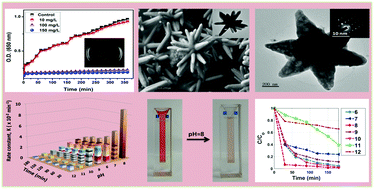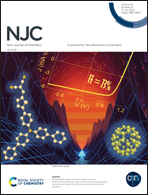Morphology engineering of ZnO nanorod arrays to hierarchical nanoflowers for enhanced photocatalytic activity and antibacterial action against Escherichia coli†
Abstract
A facile and efficient hydrothermal route has been employed for the synthesis of uniform ZnO hierarchical nanoflowers without using any templates, seeds or substrates. The nanostructures (ZnO-1 to ZnO-4) were obtained by reacting [Zn2(bpma)2(adc)2]n (bpma = N,N′-bis(pyridylmethyl)methyl amine; adc = acetylene dicarboxylate) with aqueous KOH (pH > 13) under hydrothermal conditions at 180 °C for 6–24 hours. The post-synthesis annealing of ZnO-1 to ZnO-4via direct calcination at 500 °C for 6 hours provided ZnO-1a to ZnO-4a, respectively. The petals of the flower-like nanostructures were constructed by many well aligned ZnO nanorods possessing a typical tapering feature with an average diameter of 32 nm. Using powder X-ray diffraction (PXRD), field emission scanning electron microscopy (FESEM), energy dispersive X-ray spectroscopy (EDX) and transmission electron microscopy (TEM), the nanoflowers were found to be single crystalline in nature, with a hexagonal phase, and with growth along the [0001] direction. The TEM images of ZnO-3, ZnO-3a, ZnO-4 and ZnO-4a confirm the formation of rods with a d-spacing of 0.26 to 0.29 nm. The evolution of the flower-like morphology with different growth times (6, 12, 18 and 24 hours) has been discussed based on the different crystallographic habits of wurtzite hexagonal ZnO. The optical properties were investigated by solid state diffuse reflectance spectra with band gap energies in the range of 3.16–3.20 eV. Photoluminescence spectra of all nanostructures displayed the emission in the blue region between 410 and 430 nm due to intrinsic defects in ZnO. Interestingly, a systematic increase in intensity has been observed for an increase in the aspect ratio, resulted from aging from 6 hours to 24 hours for ZnO-1 to ZnO-4; the same trend is also observed with the annealed nanostructures. Their photocatalytic activities were assessed with cationic methylene blue and anionic Congo red, where the latter showed the maximum activity at pH = 8. An increase in the degradation rates is fully correlated with higher aspect ratios of the rods. Furthermore, the antibacterial effectiveness of ZnO-1 has been tested on E. coli at different dosages (10, 100 and 150 mg L−1) and the maximum inhibition was found at 150 mg L−1.



 Please wait while we load your content...
Please wait while we load your content...